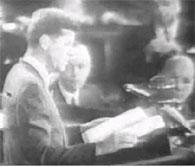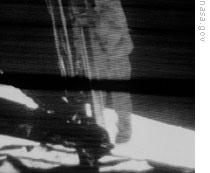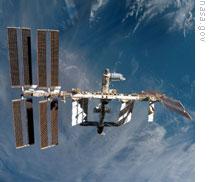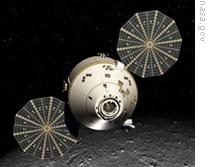VOA慢速英语-EXPLORATIONS - America's Space Agency Turns 50
时间:2018-12-07 作者:英语课 分类:VOA慢速英语2008年(七)月
A look back at a few of the most important programs that NASA has carried out in half a century of exploration. Transcript 1 of radio broadcast:
29 July 2008
VOICE ONE:
I'm Barbara Klein.
VOICE TWO:

Earth and the moon as photographed by the Apollo 11 astronauts
And I'm Steve Ember with EXPLORATIONS in VOA Special English. This month, the United States space agency celebrates its fiftieth anniversary. Today we tell about some of the high and lows of those fifty years.
(MUSIC)
VOICE ONE:
NASA was established on July twenty-ninth, nineteen fifty-eight when President Dwight D. Eisenhower signed the National Aeronautics 2 and Space Act. The agency was created mainly because of competition between the United States and the former Soviet 3 Union.
The Soviet Union had become the first country to put an object into orbit around the Earth. The successful launch of the Sputnik satellite on October fourth, nineteen fifty-seven marked the start of "the space race."
VOICE TWO:
NASA began operations on October first, nineteen fifty-eight from headquarters in Washington, D.C. Its first major goal was to show that people could survive and work in space. This was called Project Mercury. NASA chose seven military pilots to be the nation's first astronauts.
But in April, nineteen sixty-one, the Soviets 4 put Yuri Gagarin into orbit around the Earth. NASA had been beaten to its first goal. Soon, however, President John F. Kennedy gave NASA a greater goal, bigger than anyone had considered at that time. He made this statement on May twenty-fifty, nineteen sixty-one.

President Kennedy speaking before Congress on May 25, 1961
PRESIDENT JOHN KENNEDY: "I believe that this nation should commit itself to achieving the goal, before this decade is out, of landing a man on the moon and returning him safely to the Earth. No single space project in this period will be more impressive to mankind or more important to the long-range exploration of space. And none will be so difficult or expensive to accomplish."
VOICE ONE:
Project Mercury was a success scientifically and in the opinion of the American public. All of the first six space flights were in small one-man capsules. Tom Wolfe wrote a book about the first astronauts and their flights, called "The Right Stuff." These brave astronauts became American heroes. They included John Glenn who was the first American to orbit the Earth in nineteen sixty-two.
The next step was Project Gemini. These spaceships could hold two men. The flights showed that astronauts could fly in space, do complex tasks like linking with other space vehicles and even work outside their spacecraft.
VOICE TWO:
Project Apollo was NASA's biggest effort up to that time. The Apollo spacecraft could hold three astronauts. It was powered by a huge Saturn 5 Five rocket, the first rocket designed by NASA only for space exploration. But the project began with tragedy. In early nineteen sixty-seven, three astronauts were killed in a fire while testing Apollo One.

Neil Armstrong becomes the first person to step on the moon
Space scientists learned important lessons from the disaster and the following missions were successful. The most exciting one was Apollo Eleven. It landed astronauts Neil Armstrong and Buzz Aldrin on the moon's Sea of Tranquility. Hundreds of millions of people around the world watched Neil Armstrong take his first step on the moon on July twentieth, nineteen sixty-nine.
NEIL ARMSTRONG: "That's one small step for man. One giant leap for mankind."
VOICE ONE:
Five more flights landed on the moon, ending with Apollo Seventeen in nineteen seventy-two. A total of twelve Americans walked on the moon. Steven Dick, NASA's chief historian, has written about the effect of the Apollo project on society, especially its view of Earth from the moon. He wrote: "The photographs of 'Earthrise", and of the full Earth as a blue marble suspended in space, fragile and without national boundaries, changed humankind's view of Earth forever."
VOICE TWO:
The success of Apollo ended the space race. It also provided a chance for Americans and Soviets to join in the first international space flight, the Apollo-Soyuz Test Project in July of nineteen seventy-five. The project was the start of cooperation in space. It was also the end of the first part of NASA's manned spaceflight program.
(MUSIC)
VOICE ONE:

The first shuttle launch on April 12, 1981
In nineteen seventy-two, President Richard Nixon approved a completely new space project. It would be the world's first reusable space vehicle. The project was the space shuttle program--officially known as the Space Transportation System. Shuttle Columbia, one of five orbiters, made the first flight of the program in April, nineteen eighty-one.
(SOUND)
The space shuttle program has carried many satellites into orbit. It has launched several space exploration vehicles such as the Galileo and Magellan spacecraft. The shuttle also put the Hubble Space telescope into orbit and has serviced the thirteen-meter-long telescope four times. Hubble has discovered planets beyond our solar system and confirmed black holes. It has even helped scientists know the exact age of the universe.
VOICE TWO:

The International Space Station in February 2008
The space shuttle program is closely linked with international efforts to have a permanent presence in space. The shuttle has helped build the International Space Station whose first crew arrived in November of two thousand. The Space Station is expected to be completed in two thousand ten. That year will also be the last for space shuttle missions.
But NASA's space shuttle program has also been marked with tragedy. In January of nineteen eighty-six, the shuttle Challenger exploded seventy-three seconds after launch, killing 6 all seven astronauts. Two years later, the shuttle program returned and flew eighty-seven successful missions. But tragedy struck again in February, two thousand three. The shuttle Columbia came apart while reentering the Earth's atmosphere. Seven more astronauts died. These incidents remind everyone of the risk of space travel and the bravery and sacrifice of the astronauts.
(MUSIC)
VOICE ONE:
In the last fifty years, NASA has sent robotic spacecraft to the moon and all the planets. In the nineteen sixties, the space agency first started to explore other planets with the Mariner 7 probes. A series of Mariner spacecraft visited the planet Venus. Years later, the Magellan spacecraft mapped Venus in great detail.
In nineteen seventy-four, Mariner Ten visited Mercury, the closest planet to the sun. NASA returned to Mercury in two thousand eight with the Messenger spacecraft.
VOICE TWO:
Among the most successful of NASA's robotic explorers are the Voyager One and Two spacecraft. They built on the success of the earlier Pioneer Ten and Eleven. Voyager One visited Jupiter and Saturn.
Voyager Two added Uranus 8 and Neptune 9 to the list of planets NASA has visited. It discovered rings and many new moons orbiting those worlds. Today, Voyager One has traveled farther than any other object made by humans. It is almost sixteen billion kilometers from the sun, beyond the reach of the flow of particles known as the solar wind.
The Galileo mission to Jupiter and the Cassini/Huygens mission to Saturn have greatly increased our knowledge of the two giant planets.
VOICE ONE:

An artist's picture of the Phoenix 10 Mars Lander
NASA has visited Mars more often than any other planet. Mars continues to interest scientists searching for life because it is known to have water. Mariner spacecraft first visited the planet in the nineteen sixties. In the mid 11 nineteen seventies, the Viking One and Two spacecraft returned detailed 12 pictures of the red planet. The Viking project also put landers on Mars and tested its soil.
More than twenty years later, NASA returned to Mars with its Global Surveyor. Several missions to Mars during this period failed. But spacecraft like the Mars Odyssey 13 and the Mars Exploration Rovers have gathered huge amounts of information about the planet. The Mars rovers, Spirit and Opportunity, continue to operate on the red planet along with the Phoenix Mars Lander.
VOICE TWO:

An artist's picture of the Orion Crew Exploration vehicle orbiting the moon
We have had time to discuss only a few of the most interesting programs of NASA's past and present. Today, NASA is a huge agency with almost nineteen thousand employees who work at ten main centers around the country. Its budget for two thousand nine is about seventeen and a half billion dollars.
NASA is already planning the next generation of exploration vehicles. They include the Orion Crew Exploration Vehicle and a reusable moon lander. And NASA plans to establish a center to produce power on the moon by two thousand twenty-four.
Yet the return to the moon is only the first small step. Anyone who works for NASA will tell you that Mars is the next goal for human spaceflight. And there is no reason to think that the urge to explore will end after that goal is reached.
(MUSIC)
VOICE ONE:
This program was written and produced by Mario Ritter. I'm Barbara Klein.
VOICE TWO:
And I'm Steve Ember. For more information about NASA, visit our Web site, voaspecialenglish.com. Join us again next week for Explorations in VOA Special English.
- A transcript of the tapes was presented as evidence in court.一份录音带的文字本作为证据被呈交法庭。
- They wouldn't let me have a transcript of the interview.他们拒绝给我一份采访的文字整理稿。
- National Aeronautics and Space undertakings have made great progress.国家的航空航天事业有了很大的发展。
- He devoted every spare moment to aeronautics.他把他所有多余的时间用在航空学上。
- Zhukov was a marshal of the former Soviet Union.朱可夫是前苏联的一位元帅。
- Germany began to attack the Soviet Union in 1941.德国在1941年开始进攻苏联。
- A public challenge could provoke the Soviets to dig in. 公开挑战会促使苏联人一意孤行。
- The Soviets proposed the withdrawal of American ballistic-missile submarines from forward bases. 苏联人建议把美国的弹道导弹潜艇从前沿基地撤走。
- Astronomers used to ask why only Saturn has rings.天文学家们过去一直感到奇怪,为什么只有土星有光环。
- These comparisons suggested that Saturn is made of lighter materials.这些比较告诉我们,土星由较轻的物质构成。
- Investors are set to make a killing from the sell-off.投资者准备清仓以便大赚一笔。
- Last week my brother made a killing on Wall Street.上个周我兄弟在华尔街赚了一大笔。
- A smooth sea never made a skillful mariner.平静的大海决不能造就熟练的水手。
- A mariner must have his eye upon rocks and sands as well as upon the North Star.海员不仅要盯着北极星,还要注意暗礁和险滩。
- Uranus is unusual because it is tilted.天王星非常特殊,因为它是倾斜的。
- Uranus represents sudden change and rebellion.天王星代表突然性的改变和反叛。
- Neptune is the furthest planet from the sun.海王星是离太阳最远的行星。
- Neptune turned out to be a dynamic,stormy world.海王星原来是个有生气、多风暴的世界。
- The airline rose like a phoenix from the ashes.这家航空公司又起死回生了。
- The phoenix worship of China is fetish worship not totem adoration.中国凤崇拜是灵物崇拜而非图腾崇拜。
- Our mid-term exam is pending.我们就要期中考试了。
- He switched over to teaching in mid-career.他在而立之年转入教学工作。